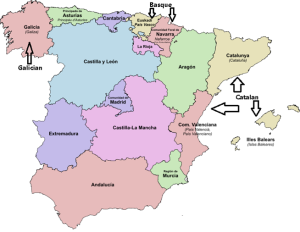If you’re a language fanatic, like me, perhaps you lie awake at night counting irregular verbs:

I’m not that far gone, but I am curious about these pesky beasts. A specific question I’ve had about irregular verbs in Spanish concerns the present tense in particular. Every textbook lists “some common verbs” of the main types, mainly “boot” verbs and -zco, but I’ve never seen an exact count, or an exhaustive list.
I think I’ve now come close thanks to the intro2spanish website (with which I am not affiliated). Below is a summary table of the number of verbs listed there from the various irregular categories, broken down by category and by conjugation class (-ar, -er, -ir). I haven’t included the miscellaneous irregulars like sé, veo, nor the small -go class, because these are covered in every textbook.
| -ar | -er | -ir | TOTAL | |
| e > ie | 44 | 21 | 35 | 100 |
| o > ue | 47 | 22 | 2 (dormir, morir) | 71 |
| u > ue | 1 (jugar) | *** | *** | 1 |
| e > i | *** | *** | 42 | 42 |
| -zco | *** | 76 | 14 | 90 |
You can download a complete listing of the irregulars here: irregular verb list. If you can think of any others, please let me know so I can update the list and the table.
Here are some interesting patterns in the data:
- Jugar is clearly anomalous. It derives from Latin iocāri, and should have come into Spanish as just another o > ue verb, jogar. The infinitive’s change from jogar to jugar is a mystery to Spanish historical linguists. My favorite explanation is Tom Lathrop’s purely speculative one: that the infinitive jogar might have become jugar out of “self-defense” as speakers avoided saying something so similar to joder (“to f*ck”). You can read a longer explanation in this article (in Spanish) or on p. 160 of Lathrop’s The Evolution of Spanish:
- I had no idea there were that many -zco verbs, or that -ir verbs outnumbered -er verbs within the e > ie type. Todos los días se aprende algo.
- If you were surprised that all e>i verbs are -ir, then you should (re)read my previous post about boot verbs. The e>i change was triggered by the /j/ sound, which only occurred in Vulgar Latin -ir verb endings. (To be picky, it actually occurred in -er endings too, but was lost in these before it had the chance to do much damage.)
- It’s awesome that only two -ir verbs have the o > ue pattern. As explained in my previous post, the other -ir verbs that started to go down this road switched to a u instead, which spread around the whole conjugation. That’s where we get (inter alia) mullir and subir.
Sleep well!


 The Native American population of New Mexico belongs either to the various Pueblo tribes or to the Navajo Nation. And “Anglo”? Well, that basically means “none of the above”, whether you’re a white Jewish girl from New York, a graduate student from France, or an African American.
The Native American population of New Mexico belongs either to the various Pueblo tribes or to the Navajo Nation. And “Anglo”? Well, that basically means “none of the above”, whether you’re a white Jewish girl from New York, a graduate student from France, or an African American.




